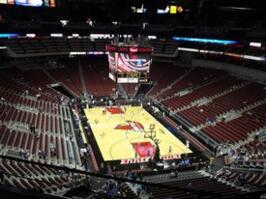The Madness of Slamming Midnight Basketball
A Commentary By Froma Harrop
Eighteen years ago, "midnight basketball" was the big har-har-har on the conservative talk circuit. It was a federal program that sought to coax young men off the late-night mean city streets and onto supervised basketball courts.
This $40 million item was a speck in a $33 billion crime bill. (For further contrast, advertisers last year spent $614 million on the March Madness college basketball tournament.) But you wouldn't have fathomed the smallness of the six-year program from the relentless lampooning and slamming it took at Republican hands.
Texas Rep. Lamar Smith quipped that it worked on "the theory that the person who stole your car, robbed your house and assaulted your family was no more than a disgruntled artist or would-be NBA star." In his 1996 campaign for president, Republican Kansas Sen. Bob Dole called midnight basketball "a subtle and sickening appeal to racism."
The big irony here is that midnight basketball started off as one of Republican President George H.W. Bush's "thousand points of light." In 1989, Housing and Urban Development Secretary Jack Kemp worked with the Chicago Housing Authority to get it off the ground.
University of Minnesota sociologist Douglas Hartmann compacts the political timeline as follows: "Republicans actually started the program, Bill Clinton in his classic fashion claimed it, then Republicans turned on the program."
Midnight Basketball may have been chiefly aimed at young urban blacks, but the concept of organized basketball as a diverter from crime has applied equally well to white suburban kids. One such beneficiary was a troubled boy from eastern Massachusetts, who grew up to be Republican Sen. Scott Brown.
In his autobiography, "Against All Odds: My Life of Hardship, Fast Breaks, and Second Chances," Brown talks of a childhood made miserable by poverty and his mother's parade of abusive men. Boiling with anger, Brown tumbled into a series of failures, culminating in an arrest for shoplifting. Then came basketball.
From junior high through college, basketball gave Brown a healthy way to blow off steam. It put him in contact with coaches who became the guiding fathers he lacked at home.
His high school coach, Ellis Lane, had him baby-sit for his kids once or twice a week. This gave Brown some food to eat, money for dates and exposure to normal family life. Importantly, it offered an escape from his latest violent alcoholic stepfather.
When it came time to choose a college, Lane steered him to Tufts, largely because of the coach there. John White had suffered many of the same childhood deprivations as Brown and found his salvation in basketball. He would be an ideal mentor.
Though he went to Tufts on a scholarship, Brown needed money just to live. His father had stopped sending checks for child support. "Instead," Brown writes, "Coach White and I went back to the financial aid office and begged for more money for me, so that I could cover books and a meal plan."
According to Brown, he did well in college basketball but was clearly not headed for the professional game. So it was off to law school.
March Madness has become a cherished national institution, bathed in lore about brackets and seedings. And it's rolling in money. But a small federal program to use basketball leagues as alternatives to the thug- and drug-infested streets was treated as some ludicrous trinket of the welfare society. It's now funded mainly on the local level.
"We don't mind spending the money on March Madness, and yet we're extremely stressed about putting little bits of money into programs for kids on the street," Hartmann concluded. "Talk about madness."
COPYRIGHT 2011 THE PROVIDENCE JOURNAL CO.
DISTRIBUTED BY CREATORS.COM
See Other Political Commentary.
See Other Commentaries by Froma Harrop.
Views expressed in this column are those of the author, not those of Rasmussen Reports. Comments about this content should be directed to the author or syndicate.
Rasmussen Reports is a media company specializing in the collection, publication and distribution of public opinion information.
We conduct public opinion polls on a variety of topics to inform our audience on events in the news and other topics of interest. To ensure editorial control and independence, we pay for the polls ourselves and generate revenue through the sale of subscriptions, sponsorships, and advertising. Nightly polling on politics, business and lifestyle topics provides the content to update the Rasmussen Reports web site many times each day. If it's in the news, it's in our polls. Additionally, the data drives a daily update newsletter and various media outlets across the country.
Some information, including the Rasmussen Reports daily Presidential Tracking Poll and commentaries are available for free to the general public. Subscriptions are available for $4.95 a month or 34.95 a year that provide subscribers with exclusive access to more than 20 stories per week on upcoming elections, consumer confidence, and issues that affect us all. For those who are really into the numbers, Platinum Members can review demographic crosstabs and a full history of our data.
To learn more about our methodology, click here.



